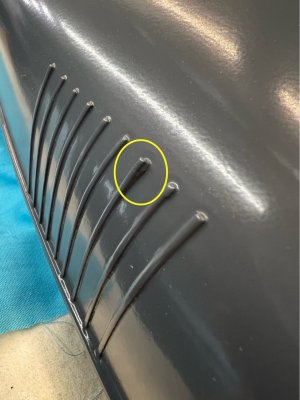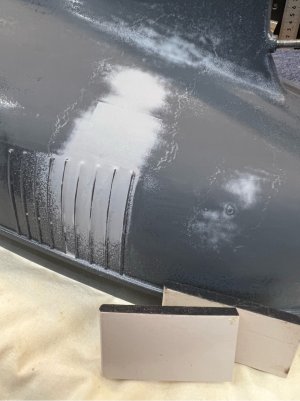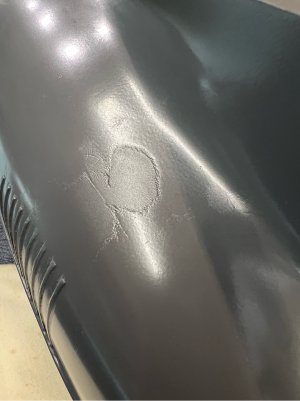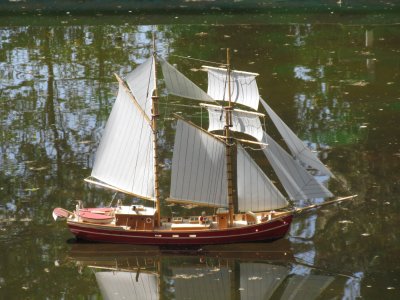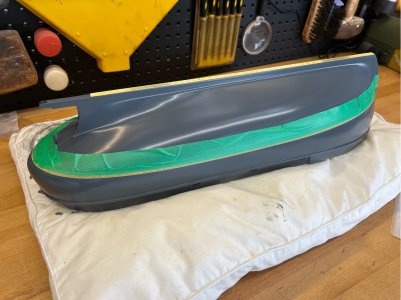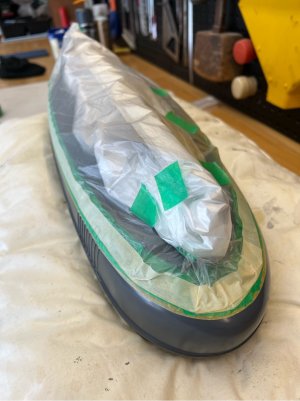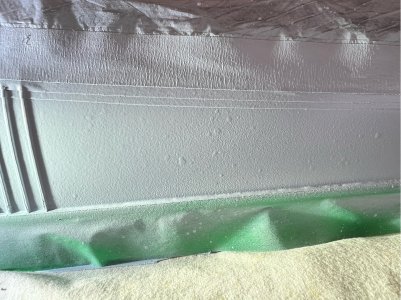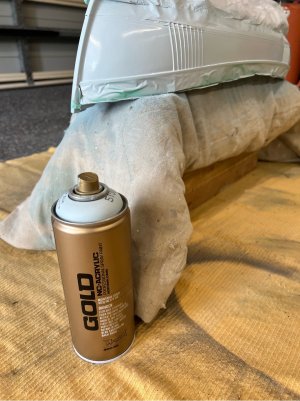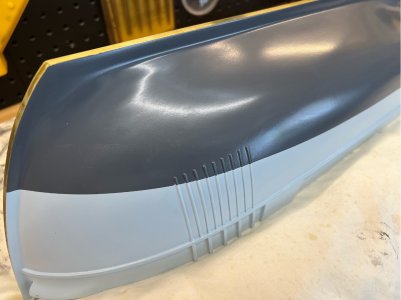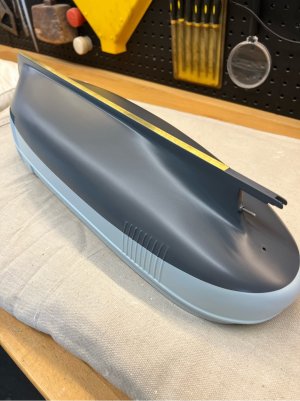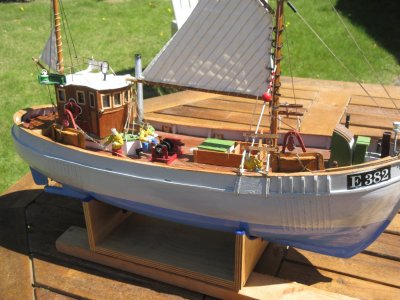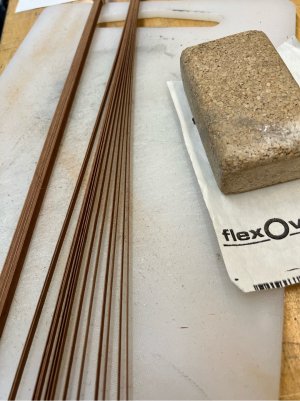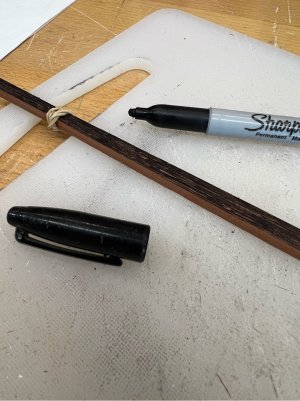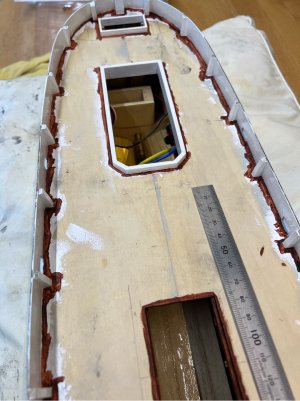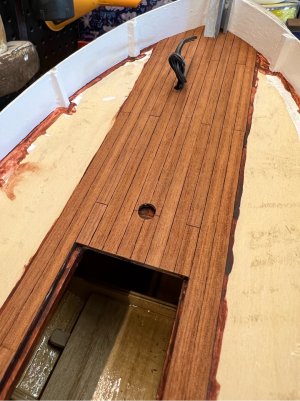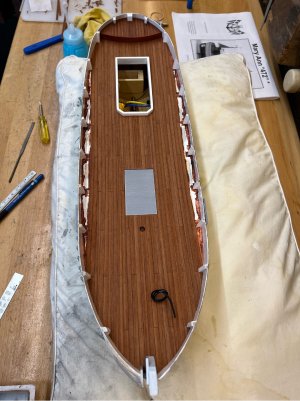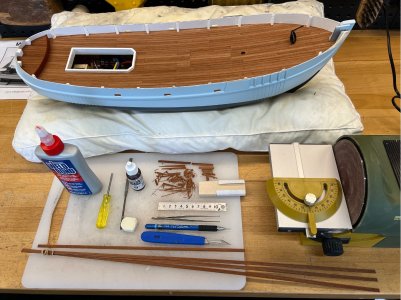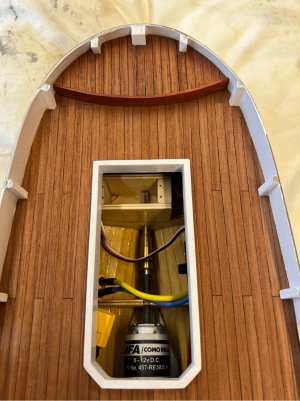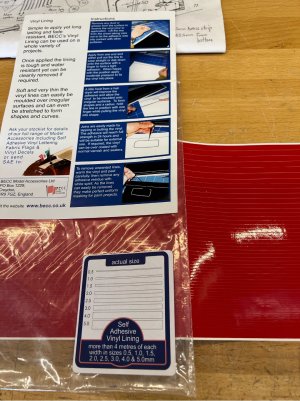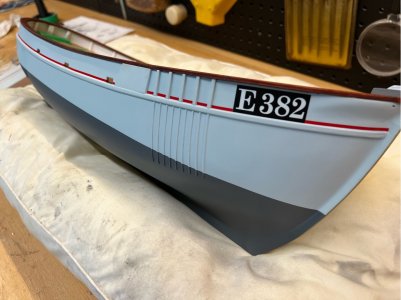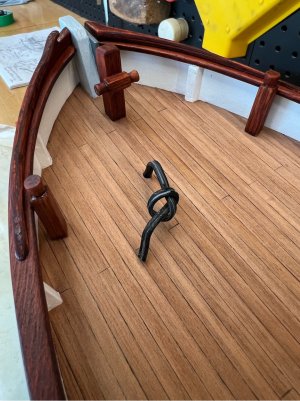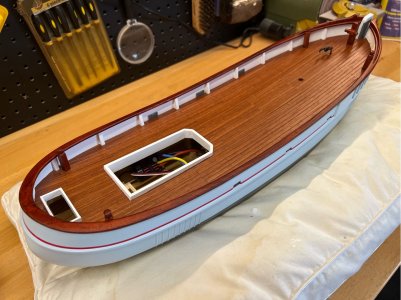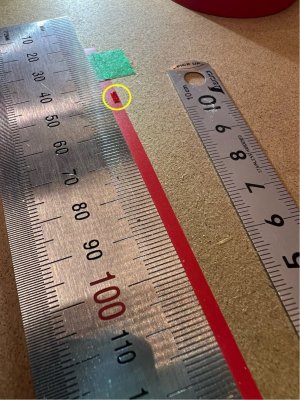Sanding the deck
Before I get started on the capping rail, I thought that I probably should get the deck sanding out of the way, so that I don’t damage the rail later. I did ‘umm and ahh’ a bit about whether to sand it at all…I was thinking that a rougher look might look more workman-like, but I’m sure that with a bit of work in real-life, the decks wouldn’t have many square edges on the planks for very long. So, I gave it a sand with quite small block of mdf and 240 grit dry paper. It didn’t take long as the surface was pretty flat to start with, but it’s worth doing to remove the few splinters on some edges and to reduce and dull the edge marking of the planks that replicates the caulking. There are plenty of tricky spots to sand around, but I ended up wrapping a small strip of paper around the shoe of a painter’s trowel and that did a good job in those spots…easy to control.
 The Capping Rail
The Capping Rail
The kit provides four laser-cut 3-ply sections to fabricate the fore and aft sections of the capping rail / handrail. They then suggest completing the runs up each side with leftover planking timber to join the laser-cut ply sections. To my eye this is not a great solution for a component that gets seen every time you look at the boat…different thicknesses and different types of timber. I also found that the pre-cut curves didn’t match super well to the shape at the top my bulwark…the overhang varied around the hull, probably due to my build.
Anyway, I decided to make them from scratch from some sheet wood that I have in stock. I started with the kit sections as a template and altered the shape where it needed to be and shaped and then sanded away an afternoon until I was happy with the result. I also elected to replace the rails in the section between the end pieces, with similar section timber, so everything matches in size and colour.
I did try pre-bending the side rails by wetting them and clamping them to their respective bulwark sides overnight, but that didn’t really work…perhaps because it’s a relatively small bend, so they will just be glued to the shape needed. These rails are being finished with the same Sikkens Cetol Mahogany (an external decking oil) used in a few places. Then they will be sprayed with a clear matte finish along with the rest of the boat at the end.
As mentioned, the rails need some subtle bending to match the shape of the bulwark top and stanchions, and I imagine that they will need to be able to take a bit of ‘weight’ given that they are so exposed and will get handled regularly, so I’ll be using a 5 min epoxy glue (Araldite’s ‘Ultra Clear’) along the top of the bulwark edge and atop the stanchions. It gives me a little time for some subtle repositioning once I’ve got the rail in place and it’s clamped in position, and it is reasonably easy to clean up the minor amount of squeeze-out. It also dries clear, so it won’t mark the exterior paint work.
The downside is that the rail needs to be held in position, under light pressure for about 8hr (I leave it overnight). This is a tricky area to clamp because the bulwark is very thin compared to the rail and it needs to have a slight bend added to it to match the flowing sheer of the deck. After trying a few clamping options, I ended up using rubber bands for most of the effort, and a couple of screw-in planking clamps to locate each end and prevent movement while the epoxy sets. The clamp at the stern is holding the end edge down against the stanchion, while the clamp at the other end is simple acting as a spike to prevent the rail end being pulled in toward the centre of the hull. In this case, the rubber bands apply enough force it to set the small sheer curve needed. You can see that I added some plastic sheeting under the bands around the hull to make sure I didn’t get any pressure marks (as I did before). As it happens, I’ve found that the exterior paintwork is now much more robust after having had a couple of coats of clear acrylic added.
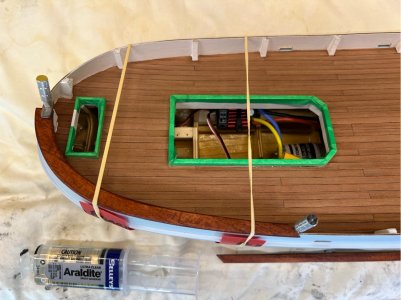
Because I’m using the epoxy glue, and I need to clamp it, I’m only doing a single section of rail each day. The other side of the stern rail is a little tricky because I can’t use the rear planking clamp this time…I’d have to put a hole in the timber of the rail, so I’ll just weight it down instead. You have to get a bit imaginative to find something that works…here I’ve used an inverted small anvil, balanced perfectly, with some protective timber and plastic to make sure I don’t mark anything. The screw-in clamp on the leading edge is again being used as a spike for the rail to pull against.
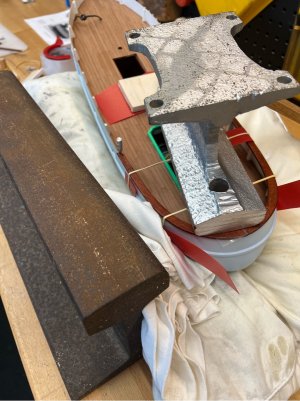
When I unclamped this section the following morning, the new piece was perfect, but the stern-end of the other side had pulled up a little from the stanchion, so I used some thin CA in a hypodermic syringe to inject some glue between the ends of two pieces of railing and also under the first end. This was held in place for a while and has fixed the problem.
Next, I moved to the two shaped pieces at the bow. The two sides are different because the starboard side has to accommodate a gap that holds the pulley for the anchor chain and it also has to cover the area where the bulwark bulges out to prevent the anchor catching on the railing (I assume that is the reason for the bulge). The port side is fairly simple, I just made sure that the nose of the railing meets the bow stem at the same place that the other side will when it is added, and that the amount of external overhang is the same along the length of the bulwark. I’m using 2mm overhang all around…it’s not specified, but seems about right, it also means that where there are rubbing boards along the bulwark that they will sit flush, as you would expect. Again, I had to fashion some stays and weight for clamping. I found that short offcuts of wood with an appropriate step cut in each end allowed me to fit a temporary stay without it slipping out and then hold it all down with rubber bands. Same epoxy used here.

The starboard side is similar, except you need to make sure that the railing is lined up with a gap for the anchor chain pulley, and with the offset for the bulge under the railing. Gluing and clamping was the same as for the port side. I had to do a little re-profiling of the bulwark and stanchions to make sure that the rail to lean into the boat a little
To join the fore and aft sections, I cut a couple of lengths of the same timber used to make the sections at each end. The joins at each end will use a simple plain scarf cut with the cut vertical (ie you see the diagonal when looking down from above). I’ve chosen to make each diagonal joint in opposite directions at each end, because they are easier to fit – the rail will not slip away from the side when I apply a little internal sideways force to put the edge bend in them. The railing on the starboard side is the same, with the joints cut in the opposite direction.
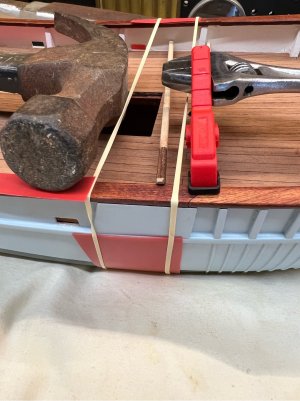
And here is the finished job. The extra mouldings on top of the forward sections have to be added yet - a simple gluing job. The joins in the cap rail required some minor sanding and re-finishing, but it has come up quite nicely and makes the hull look finished.

All that remains to be done now, is to apply the external red stripe above the rubbing strake and then give the outer bulwark, cap railing, inner bulwark and deck a few coats of matte acrylic spray for protection, before starting the fit-out of the deck.



